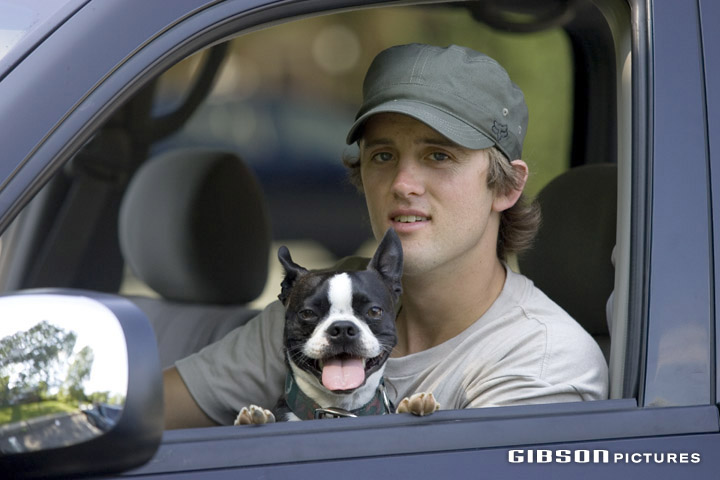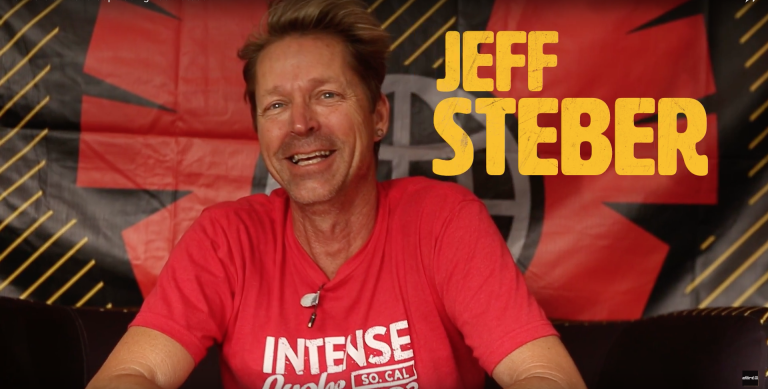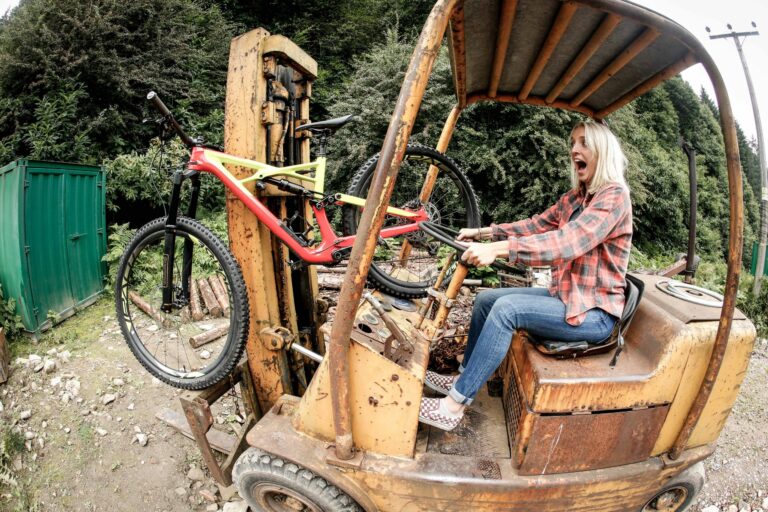
Since Aaron Chase’s film debut in Chain Reaction, he’s gained a reputation as one of the most innovative riders on the freeride/jump/street scene. Having developed his film-making technique helping out with the making of later Chain Reactions he made his own film, Killing Time. We met up with him in London, where he was promoting his new film Counterparts…
Where and when did it all start?I got sponsored by Cannondale straight out of high school in ’97. That was for racing, but now I’m strictly freeriding or whatever I want to do. And that kind of came around about two years ago. I’ve just been able to do my own programme and pick up the events I want to do and stuff like that.
The Cannondale deal works well for you then? You get your own signature bike and stuff.Yeah. They were the first company to invest anything in me and brought me through a team and into the mix, and now I’ve got good relationships with the company. They’re definitely huge, just to step up through the ranks and kind of mature, into my spot now. They send me all over the world and keep me going – I don’t have to work a nine-to-five or anything like that.
Any plans for the new bike next year?The main change that I made from the ’05 bike is a considerably shorter back end, almost an inch shorter – they redesigned the yoke at the bottom bracket. So basically the rear tyre’s a lot more snug and still plenty of room if your rear wheel warps. Of course we’ve redone the graphics. For the most part the geometry is the same.
Do you get much of a say in the geometry?Yeah, it’s all me for the most part. They come to me with everything from the graphics to the design and everything else. Who better to design the Chase bike than myself, that’s our whole understanding behind it. They have the know-how and I’ve got the background and know what’s going to float for a jump bike.
You get to travel a lot. Is there an event or location that really stands out?Any event that Red Bull does is instantly going to be the stop of the year. Anything that they have their hands in just turns to gold pretty much. Their event in Nuremberg this year ended up going huge. The District Ride in Enheim, I walked away with the win from that one. That was probably the biggest win of my career so far.
You’re over in London promoting your new film, Counterparts. What was it like making the film?It’s all fun pretty much. I’m lucky enough to work with Don [Hampton, Chain Reaction producer] who gets to do all the dirty work. I get to do all the fun stuff and he helps out with the other logistical stuff that kind of poops out the energy from you. For me it’s pretty cool, I get to hike around with the camera and film what goes on and really take a different perspective on things than other film-makers may do.
 What was it like going from just riding to riding for film?
What was it like going from just riding to riding for film?
It’s easy. I’ve always pretty much done that in the past anyway. Whenever I’m around or something’s gonna happen I take the video camera out and film it. After a year or so, travelling to so many spots and filming stuff, you end up with a big mountain of footage that you definitely have to use for something. And riders in there that hadn’t even be noticed so far, like George Ryan – I knew that when the video came out that some of these riders would get recognised. It’s really fun to take that, all the memories, all the trips, documented and put it all together and package it into a video and it’s something you can have and look back to.
When the camera’s rolling, does your riding change? Do you ride differently?I guess probably, you’re not going out to kill yourself. Usually when there’s a stunt or obstacle you wanna do you instantly break out the camera. Good or bad it’s going to be worth filming. Most of the best things we get happen out of nowhere, they’re not usually planned.
Do you prefer being behind the camera now?I’d prefer to ride my bike all the time, but there’s something to be said for filming. You can bring your own style into it. Everybody’s got a different view on what’s going on and a lot of people can stand right next to the jump and film it, but if you kind of take a breath in and look around a bit and try to find some cool and interesting angles, or especially when you start making a video and editing, it totally changes your perspective on filming because now you’re not just capturing what’s going on you wanna film it so that it goes into the video. So it’s not just filming a shot, its all about shooting for the edit.
Your DVD will likely influence of whole load of kids to want to learn new tricks. Is there anyone who influenced you when you started out?I always used to look up to some of the downhillers, like Myles Rockwell, or trials guys like Colin Dray. He was one of the first guys in MTB videos who had his own thing. You never knew half the time what he was going to be doing. He’d ride all these obstacles, and I’d think, you know what, I should try that, I might be able to do that, like on a smaller scale. So for the most part watching either the top guys racing or people like Colin pushing the boundary off the race course influenced me.
You started out racing didn’t you?I raced XC when I was 14, but worked my way out of that quick because I couldn’t keep up the pace. I do about two races a year now, the US Open DH, but that’s right out of my back door. There’s local races in cool places, but I can’t really devote time to doing well, because there’s so much more freeride stuff going on.
Have you got any tips for people trying to emulate your riding?I think the best tip is to ride your style which is going to come out in everyone’s riding anyway. I think for the most part what I’m trying to do with these videos is to steer where the technical side of freeride is going. Riding in a skatepark is a good place to learn your skills, and riding street’s fun because you can jump a lot better. But I think where its going, especially for filming, is in the woods and building these obstacles bigger out of dirt, rocks and trees, that’s fresh – fresh ideas. It’s a lot more fun because we can’t get kicked out of riding a dirt pile, nobody cares. You can go out there all day long and when you get sick of it you can change it. You can add more dirt. Make it bigger, smaller, whatever you want to do. It’s a lot more true to the sport, riding that kind of way on a MTB and you need an MTB to do it. I think that’s the core part, using the advantage that you have on an MTB and using it.
Do you find it easy learning new tricks? One section in Counterparts shows you trying and trying to learn a flip fakie off a dirt wall.That’s something that I wouldn’t want to try on something like brick or Tarmac. That’s one of the benefits, when you dig it out yourself you make it exactly how you want it. And that’s some of the most fun I’ve had on my bike recently was building obstacles and riding them. I get a lot of satisfaction out of it. The flip fakie was pretty tough because of the crashes. I’ve never done a trick that you crash two or three times in one impact. You run into the wall and flip over and land on your back and the bike lands on top of you. There’s no other trick I’ve tried where you fall out of the sky. But it’s cool putting yourself in that position.
You must have had quite a few injuries in your career?Yeah, but touch wood I haven’t been doing too badly. I’ve broken collarbones, ribs, hit my head and stuff like that. It’s something that’s always in the back of your mind, but you take precautions to not getting hurt as much.
There must be more pressure on you, being a sponsored rider, not to injure yourself?You have to walk the fine line. You’re pretty much worthless if you’re always hurt and can’t do anything. But at the same time if you don’t really do a good enough jump or you suck and your sponsor says you’re not pushing that progression enough. So you definitely have to walk a fine line, but you gotta take your beatings too. The more you fall the more it teaches you the art of falling – it doesn’t become as dangerous any more I guess.
There’s quite a few riders on your level. Are there any in particular you’re keeping a close eye on?Guys like Darren Berrecloth, Paul [Basagoitia] and Cameron [McCaul]. Those guys are just coming into it. They’re bringing their own ‘just go for it’ attitude where they don’t seem like they think twice about something. There’s a bunch of guys that are always popping up at different contests and end up throwing a trick or two down that you haven’t seen before. The sport is such that, at everyone of these contests there’s more stuff that keeps getting laid down and I think it’s just like any sport, it’s just going to keep evolving.
What are you plans for the future?I just got a lot of trips. I’m going to spend a lot of time in Europe. Just staying on top of what I’ve been doing all along – all the contests, putting together real good video and just soaking up what’s going on and travel a lot. That’s really what it’s all about. Going to all these places I’ve never been, where you’ve always wanted to go.





